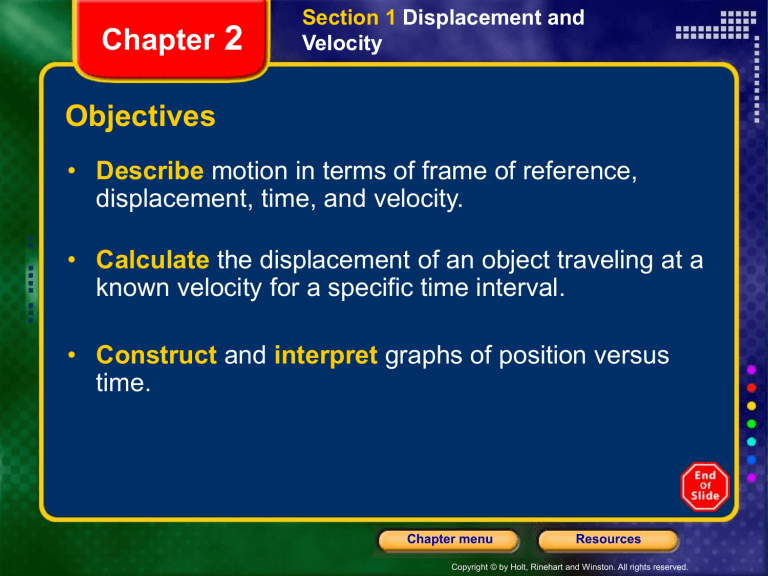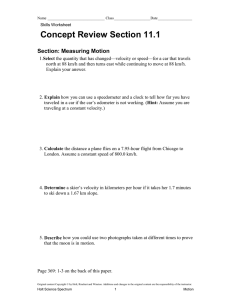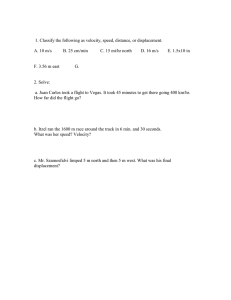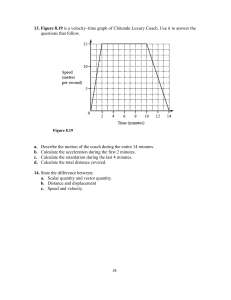
Chapter 2 Section 1 Displacement and Velocity Objectives • Describe motion in terms of frame of reference, displacement, time, and velocity. • Calculate the displacement of an object traveling at a known velocity for a specific time interval. • Construct and interpret graphs of position versus time. Chapter menu Resources Copyright © by Holt, Rinehart and Winston. All rights reserved. Chapter 2 Section 1 Displacement and Velocity One Dimensional Motion • To simplify the concept of motion, we will first consider motion that takes place in one direction. • One example is the motion of a commuter train on a straight track. • To measure motion, you must choose a frame of reference. A frame of reference is a system for specifying the precise location of objects in space and time. Chapter menu Resources Copyright © by Holt, Rinehart and Winston. All rights reserved. Chapter 2 Section 1 Displacement and Velocity Frame of Reference Chapter menu Resources Copyright © by Holt, Rinehart and Winston. All rights reserved. Chapter 2 Section 1 Displacement and Velocity Displacement • Displacement is a change in position. • Displacement is not always equal to the distance traveled. • The SI unit of displacement is the meter, m. Dx = xf – xi displacement = final position – initial position Chapter menu Resources Copyright © by Holt, Rinehart and Winston. All rights reserved. Chapter 2 Section 1 Displacement and Velocity Positive and Negative Displacements Chapter menu Resources Copyright © by Holt, Rinehart and Winston. All rights reserved. Chapter 2 Section 1 Displacement and Velocity Average Velocity • Average velocity is the total displacement divided by the time interval during which the displacement occurred. vavg Dx x f xi Dt t f ti change in position displacement average velocity = = change in time time interval • In SI, the unit of velocity is meters per second, abbreviated as m/s. Chapter menu Resources Copyright © by Holt, Rinehart and Winston. All rights reserved. Chapter 2 Section 1 Displacement and Velocity Velocity and Speed • Velocity describes motion with both a direction and a numerical value (a magnitude). • Speed has no direction, only magnitude. • Average speed is equal to the total distance traveled divided by the time interval. distance traveled average speed = time of travel Chapter menu Resources Copyright © by Holt, Rinehart and Winston. All rights reserved. Chapter 2 Section 1 Displacement and Velocity Interpreting Velocity Graphically • For any position-time graph, we can determine the average velocity by drawing a straight line between any two points on the graph. • If the velocity is constant, the graph of position versus time is a straight line. The slope indicates the velocity. – Object 1: positive slope = positive velocity – Object 2: zero slope= zero velocity – Object 3: negative slope = negative velocity Chapter menu Resources Copyright © by Holt, Rinehart and Winston. All rights reserved. Chapter 2 Section 1 Displacement and Velocity Interpreting Velocity Graphically, continued The instantaneous velocity is the velocity of an object at some instant or at a specific point in the object’s path. The instantaneous velocity at a given time can be determined by measuring the slope of the line that is tangent to that point on the position-versus-time graph. Chapter menu Resources Copyright © by Holt, Rinehart and Winston. All rights reserved.




